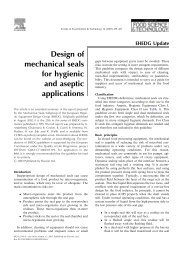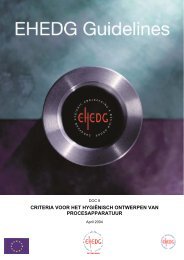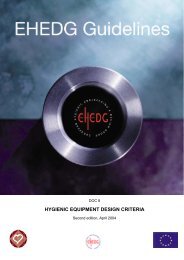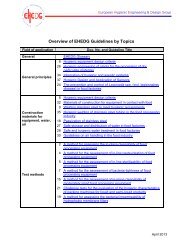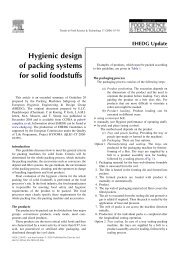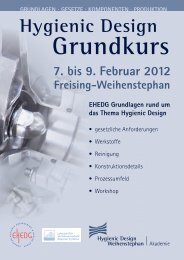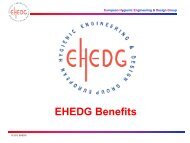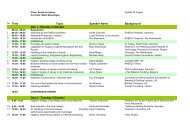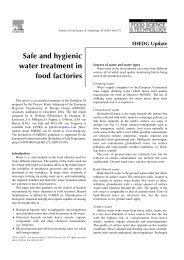Yearbook 2013/2014 - ehedg
Yearbook 2013/2014 - ehedg
Yearbook 2013/2014 - ehedg
Create successful ePaper yourself
Turn your PDF publications into a flip-book with our unique Google optimized e-Paper software.
European Hygienic Engineering & Design Group<br />
Aspects of compounding rubber materials for contact<br />
with food and pharmaceuticals<br />
Equipment and equipment components made with rubber materials that come into contact<br />
with food in processing lines must comply with regulatory requirements such as FDA’s Code<br />
of Federal Regulations (CFR), 3-A Sanitary Standards, and US Pharmacoepia (USP) Class VI<br />
standards. It is also necessary to consider the working conditions in which the gasket will be<br />
used, including what products are produced, the cleaning and sterilization agents utilized in<br />
those processes, and temperatures or other factors that may impact the efficiencies of equipment<br />
and components throughout the process line. In order to maintain a high hygienic standard, a<br />
very good cleanability of any equipment component with a rubber surface must be achieved and<br />
thorough documentation provided.<br />
Anders G. Christensen, Sales and R&D Director, AVK GUMMI A/S, Mosegaardsvej 1, DK-8670 Laasby, Denmark,<br />
email: avk@avkgummi.dk, www.avkgummi.dk<br />
For many years the food processing industry has referred<br />
to regulatory guidelines and standards that cover the use<br />
and compliance of rubber materials that come into contact<br />
with food. Among these are rules outlined in the U.S. Food<br />
and Drug Administration (FDA) 21 CFR 177.2600 (Rubber<br />
articles intended for repeat use) and the recommendations<br />
of the German BfR XXI (Commodities based on natural<br />
and synthetic rubber) or XV (silicone oil, resins and rubber<br />
requirements). Recently, 3-A Sanitary Standard 18-03 also<br />
has become a de facto standard for many food processing<br />
sectors beyond the dairy industry from which it originates.<br />
This standard not only regulates rubber materials that come<br />
into contact with food, but also the manufacturing conditions,<br />
taking hygienic standards and traceability into consideration.<br />
EN 1935/2004 is an attempt to have a common set of rules<br />
within the European Union (EU). While this regulation is<br />
fully operational with regard to metals and plastics, it is still<br />
a work-in-progress with regard to rubber materials. Until<br />
positive lists of approved ingredients that can be used in<br />
food-contact rubbers and associated testing methods are in<br />
place, the FDA and BfR lists, together with extraction tests,<br />
appear to be the most relevant regulations for food-contact<br />
rubber materials. The member states have now begun to turn<br />
this framework into statutory instruments; however, this may<br />
be at the cost of uniformity and transparency.<br />
Other standards-related developments are affecting require<br />
ments as well. For example, the Danish Ministry<br />
of Food is enforcing the rules of traceability and good<br />
manufacturing practices (GMPs) by means of third-party<br />
inspection of manufacturers’ facilities and process lines. For<br />
pharmaceuticals, normally Class VI under the USP Monograph<br />
88, testing is required. Alternatively, the customer can ask for<br />
in vitro testing, either according to USP Monograph 87 or<br />
International Standards Organisation (ISO) 10993-5.<br />
In addition, end users require documentation for cleanability<br />
of equipment surfaces. Most often this is provided by means<br />
of an European Hygienic Equipment Design Group (EHEDG)<br />
cleanability test of the component in which the rubber part<br />
is present. Except for the geometry and the corresponding<br />
flow profile, the rubber surface is typically the most critical<br />
material when conducting any hygienic test.<br />
For this reason, it is important to consider the affinity between<br />
rubber compounds, products and cleaning agents. Long-term<br />
field studies, such as those conducted by AVK GUMMI, have<br />
been conducted and have led to easy-to-clean formulation of<br />
compounds within the families of ethylene proplene rubber<br />
(EPDM), hydrogenated nitrile (HNBR), fluorocarbon (FPM)<br />
and silicone.<br />
Material performance<br />
In addition to ensuring that food-contact rubber materials<br />
have the relevant approvals, meet appropriate compliance<br />
requirements and have traceability documentation, it<br />
is important to consider material performance. No two<br />
formulations are equal. Even if two manufacturers develop<br />
a compound for the same application, the end user will<br />
experience different performances with each due to<br />
variabilities ranging from the food being produced, the<br />
production line systems, and the level of hygienic operations<br />
in the processing plant and performed on equipment, among<br />
others. The reason for this is shown in Figure 1:<br />
Figure 1. Example comparison of good quality compounds versus<br />
low-cost compounds as recipes for an EPDM 70 Sh A material.



